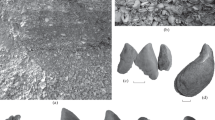Abstract
X-ray powder diffraction was used to study the calcification of the first larval shell of Ostrea edulis (sampled in Limski kanal, Istria, Adriatic Sea in April 1986) from the trochophore stage to the veliger larvae (prodissoconch I), and development of the latter up to several days postfertilization (prodissoconch II). In the first stage, only the amorphous component is present (periostracum and organic matrix). The beginning of shell formation is manifested by the appearance of calcite (up to 1–4% of the total vol.) and then aragonite (2 to 7%). In a later stage of the veliger larvae the fraction of calcite decreases, as well as the fraction of the amorphous component, while the fraction of aragonite rapidly increases. In the prodissoconch II stage, aragonite is dominant, with a very small amount of amorphous component and traces of calcite. In contrast, the valves of the adult O. edulis are composed mainly of calcite, with traces of aragonite.
Similar content being viewed by others
Literature cited
Carriker, M. R., Palmer, R. E. (1979). Ultrastructural morphogenesis of prodissoconch and early dissoconch valves of the oyster Crassostrea virginica. Proc. Natl Shellfish. Assoc. 69: 103–128
Carriker, M. R., Palmer, R. E., Prezant, R. S. (1980). Functional ultramorphology of the dissoconch valves of the oyster Crassostrea virginica. Proc. Natl Shellfish. Assoc. 70: 139–183
Hori, J. (1933). On the development of the olympia oyster, Ostrea lurida Carpenter, transplanted from United States to Japan. Bull. Jap. Soc. Scient. Fish. 1: 269–276
Horst, R. (1883–1884). The development of the oyster (Ostrea edulis L.) (Translation from Dutch by Herman Jacobson). United States Commission of Fish and Fisheries. Report of the Commissioner for 1884, part 12 (1886), p. 891–910
Hrs-Brenko, M. (1980). The settlement of mussels and oysters larvae in the northern Adriatic Sea. Nova Thalassia 4: 67–85
Kniprath, E. (1979). The functional morphology of the embryonic shell-gland in the conchiferous molluscs. Malacologia 18: 549–552
Korringa, P. (1940). Experiments and observations on swarming, pelagic life and setting in the European flat oyster, Ostrea edulis. L. Archs néerl. Zool. 5: 1–249
LaBarbera, M. (1974). Calcification of the first larval shell of Tridacna squamosa (Tridacnidae, Bivalvia). Mar. Biol. 25: 233–238
Loosanoff, V. L., Davis, H. C. (1963). Rearing of bivalve molluses. In: Russell, F. S. (ed.). Advances in Marine Biology 1. Academic Press, London, p 2–136
Marteil, L. (1976). Le conchyculture française. Rev. Trav. Inst. Pêches marit. 40: 153–346
Orton, J. H. (1936). Observations and experiments on sex-change in the European oyster (Ostrea edulis). Part V. A simultaneous study of spawning in 1927 in two distinct geographical localities. Mém. Mus. Roy. Hist. Nat. Belg. Ser. 2, Fasc. 3: 997–1056
Palmer, R. E., Carriker, M. R. (1979). Effects of cultural conditions on morphology of the shell of the oyster Crassostrea virginica. Proc. Natl Shelllfish. Assoc. 69: 58–72
Popovié, S., Gržeta, B. (1979) The doping method in quantitative X-ray diffraction phase analysis. J. Appl. Crystallogr. 12: 205–208
Popović, S., Gržeta, B., Balić-Žunié T. (1983). The doping method in quantitative X-ray diffraction phase analysis. Addendum. J. Appl. Crystallogr. 16: 505–507
Rees, C. B. (1950). The interpretation and classification of lamellibranch larvae. Hull Bull. mar. Ecol. 3: 73–104
Stenzel, H. B. (1964). Oysters: Composition of the larval shell. Science, N.Y. 145: 155–156
Waller, T. R. (1981). Functional morphology and development of veliger larvae of the European oyster, Ostrea edulis Linne. Smithson. Contr. Zool. 328: 1–70
Walne, P. R. (1974). Culture of bivalve mollusca. 50 years experience at Conwy. Fishing News (Books) The Whitefriars Press Ltd, London and Tonbridge
Wilbur, K. M. (1964). Shell formation and regeration. pp 243–282. In: Wilbur, K. M., Yonge, C. M. (eds.). Physiology of Mollusca 1. Academic Press, New York
Wilbur, K. M., Saleuddin, A. S. M. (1983). Shell formation. In: Saleuddin, A. S. M., Wilbur, K. M. (eds.). The Mollusca 4, Physiology Part 1. Academic Press, New York, p. 235–287
Yonge, C. M. (1960). Oysters. Collins Clear-Type Press, London
Author information
Authors and Affiliations
Additional information
Communicated by O. Kinne, Oldendorf/Luhe
Rights and permissions
About this article
Cite this article
Medakovié, D., Hrs-Brenko, M., Popovié, S. et al. X-ray diffraction study of the first larval shell of Ostrea edulis . Mar. Biol. 101, 205–209 (1989). https://doi.org/10.1007/BF00391459
Accepted:
Issue Date:
DOI: https://doi.org/10.1007/BF00391459




